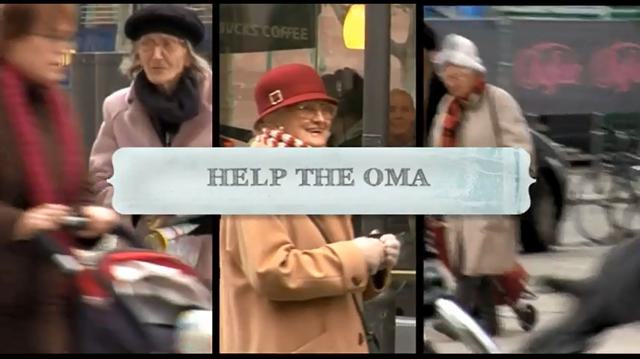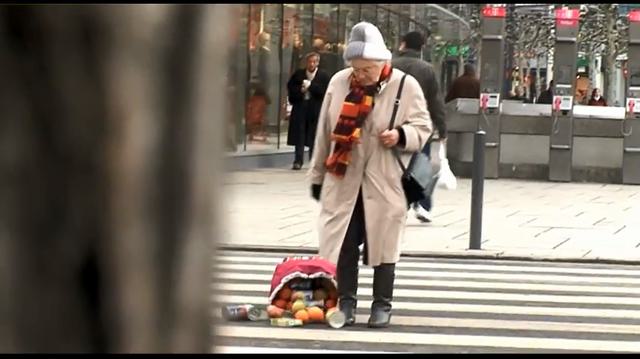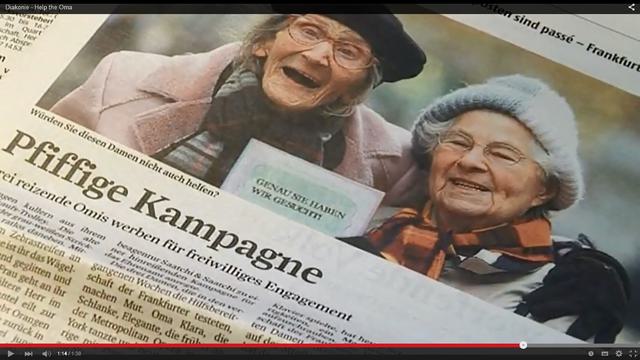Help the Oma
- Exhibited by
- Ben Swart
- Added
- February 11, 2016
- Medium of Communication
- Face to face and online
- Target Audience
- Individuals
- Type of Charity
- Welfare of elderly and vulnerable people
- Country of Origin
- Germany
- Date of first appearance
- 2010
SOFII’s view
It’s never easy recruiting new volunteers who are willing to give their time for your organisation. But this inventive campaign captured the attention of the public and went viral, leading to a hugely successful result for Diakonie Frankfurt and the vulnerable people they help.
This unique way to find volunteers was presented at IWITOT London in September 2015.
Summary / objectives
Diakonie Frankfurt knew that many elderly people in the city were vulnerable, lonely and in some cases struggling to cope with their day-to-day tasks. But they couldn’t recruit enough volunteers to help Frankfurt’s ageing population or work within other areas of social services.
‘Help the Oma’ (or Help the Grandma) was launched as an innovative way to increase awareness of the organisation and urgently find new volunteers.
Background
After many months of trying unsuccessfully to increase the number of local volunteers, Diakonie Frankfurt joined up with Saatchi & Saatchi Germany. Together they developed a campaign that would raise awareness of the organisation’s work and find more people who were willing to help others.
The campaign was designed to test how helpful Frankfurt's citizens would be and to identify the type of person that makes a good local volunteer. This was achieved in a unique way – by using three elderly actresses and placing them in situations where they would struggle with everyday challenges.
These challenges included crossing the road with heavy bags, walking up flights of stairs, or buying a ticket for public transport. Each scenario was chosen as it gave an opportunity for local people to see a person in need and show that they were a good Samaritan.
Granny Maria, 82, Granny Charlotte, 86, and Granny Klara, 89, set off to Frankfurt’s city centre and were filmed by hidden camera as they went about their daily tasks. The resulting footage created a bank of slapstick moments that were perfect for social media.
These moments helped recreate what it feels like to help a vulnerable person. And fortunately Diakonie capitalised on that feeling right there and then.
The moment a member of the public came to the aid of one of the elderly ladies they were presented with a flyer roughly translated to say 'you are exactly what we’ve been looking for. The flyer also asked them to visit a special website to learn more about the organisation and how they could help.
Creator / originator
Saatchi and Saatchi Germany, alongside Diakonie Frankfurt.
Special characteristics
The campaign’s website (www.help-the-oma.de) introduced the grannies, saluted those people who helped them and encouraged people to sign up as a volunteer. It also included detailed information about the voluntary work available, as well as photos and video footage of the grannies.
Costs
Work on this campaign was completed on a pro bono basis, thanks to Saatchi and Saatchi Germany.
Results
Diakonie’s campaign made national press and prime time news channels. Their videos of ‘Help the Oma’ went viral – and more importantly – the organisation saw a fourfold increase in the number of volunteers.
Merits
Diakonie Frankfurt found a unique way to show local people that, even if they didn’t know it yet, they were actually already the perfect volunteer.
Burkhart von Scheven, chief creative officer of Saatchi & Saatchi Germany, explained the campaign well when he said, 'The ’Help the Oma depicts only a small part of the Diakonie's work, but it illustrates what all volunteers have in common: the love for people and their desire to help others.'
Although the campaign used actresses, Saatchi and Saatchi subsequently shared that – just like any other elderly person – the grannies in the video faced real struggles in their own everyday lives:
- Granny Maria, played by Susanne Staussberg, was climbing three thousand metre peaks but today she has problems getting up a small embankment.
- Granny Charlotte, played by Hildergard Schuster, was a passionate piano player but has problems opening a marmalade jar today.
- Granny Klara, played by Elisabeth Pieper, was a dancer at the Metropolitan opera and has problems keeping up with the speed of modern life.
So although the videos may well have been staged, they represented a real life problem and a tangible solution – which went a long way in making this campaign so successful.
 View original image
View original image
 View original image
View original image
 View original image
View original image
 View original image
View original image
 View original image
View original image
Also in Categories
-
- Face-to-face
- Digital fundraising

















